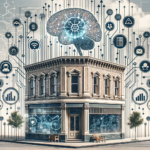
Artificial Intelligence (AI) and Machine Learning (ML) are two terms that are often used interchangeably, but they represent distinct concepts in the realm of modern technology. This blog post will demystify these terms and provide real-world examples to illustrate their differences.
What is Artificial Intelligence?
AI is a broad field of computer science focused on creating machines capable of performing tasks that typically require human intelligence. This includes problem-solving, recognizing speech, translating languages, and more. AI systems are designed to mimic cognitive functions, enabling them to act in a way that would be considered ‘smart’.
Example in Action: Virtual Assistants Consider Siri, Apple’s virtual assistant. Siri uses AI to understand natural language and perform tasks such as setting reminders or answering questions. This intelligent behavior is a product of AI, as Siri must interpret and respond to a wide array of human inquiries.
What is Machine Learning?
Machine Learning, a subset of AI, is specifically concerned with algorithms that allow computers to learn from and make predictions or decisions based on data. ML systems improve their performance over time without being explicitly programmed for each task.
Example in Action: Netflix Recommendations Netflix’s recommendation system is a classic example of ML in action. It analyzes your viewing history and compares it with that of other users to suggest shows and movies you might like. Over time, as it gathers more data, its predictions become more accurate.
The Key Differences
The primary difference between AI and ML lies in their scope and objectives. AI is the overarching concept that machines can carry out tasks smartly, while ML is the method by which machines learn from data to carry out these tasks.
Capability vs. Performance Improvement AI systems are designed to handle a variety of tasks, but ML systems are focused on improving their performance in a specific task over time. AI seeks to simulate human thought processes, while ML seeks to learn from data and improve upon it.
Programming vs. Learning AI involves more direct programming to make decisions based on input, while ML involves creating algorithms that learn patterns from data and make decisions based on those patterns.
Integrating AI and ML
In practice, AI and ML often work together. AI provides the framework for smart operations, and ML provides the means through which these operations can improve and become more sophisticated over time.
Example in Action: Autonomous Vehicles Autonomous vehicles use AI to navigate and make decisions, such as when to brake or turn. ML comes into play as the vehicle learns from vast amounts of data collected from sensors and cameras, improving its driving algorithms for better safety and efficiency.
Conclusion
Understanding the differences between AI and ML is crucial for anyone looking to engage with or understand the current tech landscape. AI is the broader concept of machines mimicking human intelligence, while ML is the practice of teaching machines to learn from data. Together, they’re shaping a future where smart machines improve and evolve with us.
Recently Added
12 Machine Learning Books for Beginners: A
- 23 January 2024
- 3 min read
The AI Checklist: Unlock Business Growth with
- 14 January 2024
- 4 min read
Unlocking Growth: The Benefits of AI Transformation
- 12 January 2024
- 8 min read
AI-Driven Decision Making in Leadership
- 8 January 2024
- 12 min read







